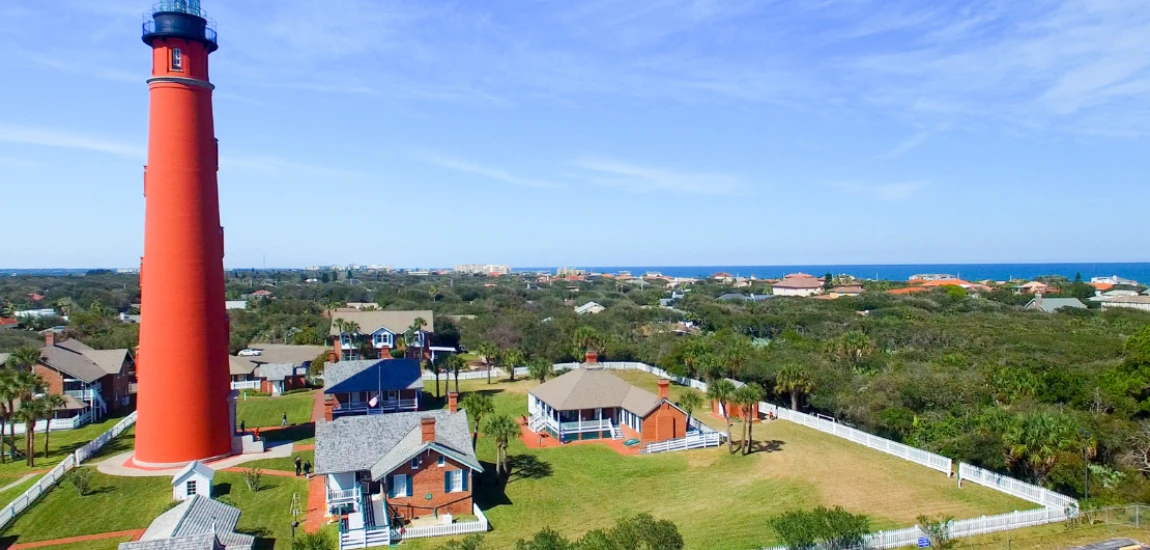Just 12 miles south of Daytona Beach, nestled in the quiet coastal community of Ponce Inlet, stands one of Florida’s most awe-inspiring historic landmarks — the Ponce Inlet Lighthouse. Officially known as the Ponce de Leon Inlet Light Station, this towering 175-foot red-brick structure has been guiding sailors since 1887 and remains the tallest lighthouse in Florida and one of the tallest in the United States. A visit here is not just a scenic outing but a step back in time.
Designated a National Historic Landmark in 1998, the lighthouse complex is one of the most complete and well-preserved light stations in the country. It features not just the lighthouse itself, but also several historic buildings and one of the largest collections of restored Fresnel lenses in the world. Visitors can climb all 203 steps to the top of the lighthouse for panoramic views of the Atlantic Ocean, Ponce Inlet, and the surrounding natural beauty of Central Florida’s coast.
From maritime artifacts to tales of lighthouse keepers, every element of the site reveals a unique story of perseverance, engineering, and life along Florida’s shores in the 19th and 20th centuries. Whether you're a history buff, a photographer, or a family looking for an educational adventure, Ponce Inlet Lighthouse promises a memorable experience.
The History and Significance of Ponce Inlet Lighthouse
The origins of the Ponce Inlet Lighthouse date back to the mid-1800s, though the current tower was completed in 1887. The first lighthouse, built in 1835 on the opposite side of the inlet, was destroyed by coastal erosion and Seminole Indian attacks. Recognizing the need for a dependable navigational aid at this treacherous stretch of Florida's coastline, the U.S. Lighthouse Board commissioned the current structure in 1883.
Constructed with over 1.2 million bricks, the lighthouse’s classic tapered design and brilliant red exterior were modeled after several successful northern lighthouses. Its first-order Fresnel lens, imported from France, could project light 18 miles out to sea — a vital safeguard for ships navigating the shifting sandbars and shallow waters near the inlet.
The lighthouse was manned by dedicated keepers and their families, who lived in the restored homes on the property, now part of the museum complex. These keepers maintained the light around the clock in often harsh and isolated conditions. The beacon was automated in 1953, marking the end of the keeper era.
Saved from demolition in the 1970s by the Ponce de Leon Inlet Lighthouse Preservation Association, the lighthouse underwent extensive restoration. It now stands as a symbol of preservation success and remains a functioning navigational aid maintained by the U.S. Coast Guard.

What to See and Do at Ponce Inlet Lighthouse Today
A visit to the Ponce Inlet Lighthouse offers far more than just a stair climb — it’s an immersive educational experience spread across multiple exhibits and beautifully restored buildings. Here’s what not to miss:
1. Climb to the Top
The main attraction is, of course, climbing the 203-step spiral staircase to the top of the lighthouse. Once you reach the summit, you’re rewarded with 360-degree views of the Atlantic Ocean, Halifax River, and the inlet. It’s a favorite photo spot and a serene vantage point for watching sailboats and spotting dolphins.
2. Explore the Keeper’s Quarters
Three restored keeper dwellings on the grounds have been converted into museums showcasing artifacts, period furniture, uniforms, and tools used by the lighthouse keepers. These exhibits provide a deep insight into daily life in the 1800s.
3. Fresnel Lens Exhibits
The lens buildings house one of the largest collections of working Fresnel lenses in the world. These intricate glass lenses, some dating back to the 1800s, are engineering marvels and were once considered the pinnacle of optical innovation.
4. The Woodshed and Oil House
These auxiliary buildings illustrate how keepers stored fuel and maintained the light. The oil house, made of fire-resistant materials, was where the kerosene needed to power the light was kept.
5. Gift Shop and Events
The lighthouse gift shop sells books, souvenirs, nautical-themed gifts, and educational materials. The site also hosts annual events, school field trips, and seasonal night climbs, offering a chance to experience the lighthouse under the stars.

Planning Your Visit: Hours, Tickets, and Tips
Planning ahead can help you make the most of your trip to the Ponce Inlet Lighthouse. Whether you're visiting solo, as a couple, or with family, here are practical tips to know before you go:
Hours and Admission
-
Open daily (except Thanksgiving and Christmas)
-
Hours: 10 AM to 6 PM (extended summer hours)
-
General Admission: ~$7 for adults, $2 for children (prices may vary slightly)
-
Free parking available on-site
Accessibility
While the museum buildings are accessible, the lighthouse itself is not ADA-compliant due to the narrow, winding staircase. Those who can’t make the climb can still enjoy virtual exhibits and videos on the grounds.
What to Bring
-
Wear comfortable shoes for climbing
-
Bring water, especially in summer
-
A camera or smartphone for stunning photo opportunities
-
Sunglasses and sunscreen for exploring the grounds
Nearby Attractions
After your lighthouse visit, consider exploring:
-
Ponce Inlet Jetty and beach – ideal for swimming and fishing
-
Marine Science Center – great for kids and sea turtle rehab education
-
Lighthouse Point Park – a dog-friendly park with trails and ocean access

Why Ponce Inlet Lighthouse Should Be on Your Florida Bucket List
With so many coastal landmarks in Florida, what makes the Ponce Inlet Lighthouse a standout destination? It’s not just its height or age — it’s the depth of its history, the integrity of its preservation, and the immersive way it connects visitors to the past.
Unlike more touristy attractions, this lighthouse remains authentic and educational, offering a genuine slice of Florida’s maritime past. Its backdrop of ocean, inlet, and forest adds a visual element few inland museums can match. Plus, it’s an easy half-day trip from Daytona Beach, making it ideal for vacationers looking to balance beach days with meaningful exploration.
For families, the lighthouse is a fun and interactive way to teach children about history, engineering, and navigation. For couples, it’s a romantic and scenic destination. And for history lovers, it’s a goldmine of Civil War-era stories, architecture, and nautical lore.
Conclusion: Standing Tall Through Time
The Ponce Inlet Lighthouse is more than a tower — it’s a symbol of Florida’s maritime resilience. It has watched over generations of seafarers and continues to stand proudly, casting its beam across the waters as a reminder of the past and a beacon for the future. Whether you’re climbing its 203 steps, exploring its museums, or simply taking in the view, the experience leaves a lasting impression.
So if your travels bring you near Daytona Beach, make time for this historic gem. You’ll leave with great photos, newfound knowledge, and a deeper appreciation for the stories told by light across the sea.






Leave a Reply